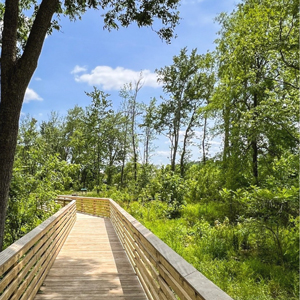Here's what the Sackett v EPA ruling could mean for the Upstate
July 14th, 2023
By Erika Hollis
Sackett v. EPA Ruling
On May 25, 2023, the Supreme Court ruled that as many as half of the 118 million acres of wetlands in the country cannot be protected by the Clean Water Act (CWA). The purpose of the CWA was to protect our navigable waters from pollution that was causing major harm in the 1960's. Visit the April 2022 Water Log Blog Post for the team's deep dive on the CWA.
In the case of Sackett v. EPA, the owners of the property, Michael and Chantel Sackett sought to develop property with plans to build a house a few hundred feet from Priest Lake, a popular vacation spot in the Idaho Panhandle. To prepare the site for construction, the Sacketts began to fill the lot with gravel. In response to a neighbor's complaint in 2007, the EPA halted the work after determining that the Sacketts' lot contained a federally protected wetland.
Under the authority of the CWA, the agency ordered the couple to remove the gravel and cease any further construction without a permit. In response, the Sacketts sued the EPA in 2008.
Over the next 14 years this case made its way through the federal court system and ultimately to the Supreme Court where the defense argued that the wetland the Sacketts filled was not a protected water of the United States because there was dry land between it and other bodies of water -- and thus not subject to EPA regulations.

Ultimately, it was determined that the wetlands on the Sackett property were not protected under the CWA. The Supreme Court came to their decision by asserting that the CWA protects waters that the 'majority' characterized as relatively permanent standing or continuously flowing bodies of water forming geographical features defined as streams, rivers, lakes and oceans.
The 'majority' went on to determine that only those wetlands that are indistinguishable from the bodies of water stated above were protected by the law under the CWA. Therefore, to protect a wetland under the CWA one must prove a surface water connection to a constantly flowing system, and it must have a continuous surface water connection with that system. This interpretation of the regulation is in direct opposition to the basic scientific understanding of wetlands, which can migrate, maintain below-ground connections, and serve as parts of larger watersheds not continuously connected by surface waters.
Consequences of this ruling
Under this new ruling the law will only provide federal jurisdiction to wetlands that are linked to major water bodies through surface connections. This decision defies the science that confirms critical underground connections of wetlands through groundwater systems. These wetlands are essential for fish and wildlife habitat in addition to protecting our quality of life by preventing and mitigating floods, filtering pollutants before they reach other bodies of water, supporting forestry, and being a means for recreation.
In addition to the benefits that isolated wetlands provide, they are also more prone to pollution as they are often adjacent to harmful land use practices. This new ruling puts these critical water bodies in jeopardy as it opens up all isolated wetlands to developers, mining companies, and other polluting industries that will harm our local environments and water quality.

Local Impacts
In the state of SC, wetlands make up 20% of the land statewide, with 6% of those wetlands located in the Upstate. Our unique Upstate wetlands provide important benefits to our state's water resources by helping protect SC's headwaters, which include drinking water resources. While isolated wetlands are very common, they are not often visible to the public.
Generally, isolated wetlands are smaller in size and aren't typically discovered until a property is being surveyed for development. Prior to the Supreme Court ruling, a case could be made for the protection of the wetland if it was within a certain distance from a waterway.
Under this new ruling, there are no such protections for isolated wetlands, which opens them up for development and other harmful land use practices. The consequences of this new interpretation of the CWA will be profound as more urban areas are developed and land is paved over and converted to impervious  surfaces. Without wetlands to slow down and filter runoff we will see more flooding and an increase in the number of polluted waterways in our communities.
surfaces. Without wetlands to slow down and filter runoff we will see more flooding and an increase in the number of polluted waterways in our communities.
Most unfortunately, more vulnerable and low-income residents who live in flood zones will experience these hazards at a higher rate. This is because many vulnerable communities reside within floodplains. Without our isolated wetlands to absorb and filter heavy rains, surges in flood waters are likely to threaten property and livelihoods of residents living closer to our waterways and flood zones.
As we start to make a path forward, it is critical that we as Upstate residents remain vigilant and empowered to advocate for the importance of wetlands in our communities. Without federal protections, many of our region's precious isolated wetlands are left exposed to the increasing demands of development. It is important to note that individual states can choose to enact stronger wetland protections as the CWA is considered just a starting point for protecting waterbodies. Therefore, we urge our readers to stay informed on this issue and reach out our state elected officials to request expanded protections for wetlands in SC.
For more information on the impacts of the Sackett v. EPA ruling, contact Clean Water Director Erika Hollis ehollis@upstateforever.org

